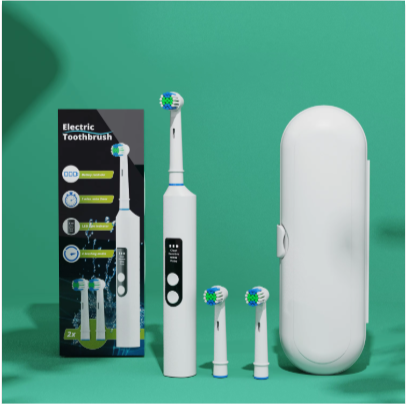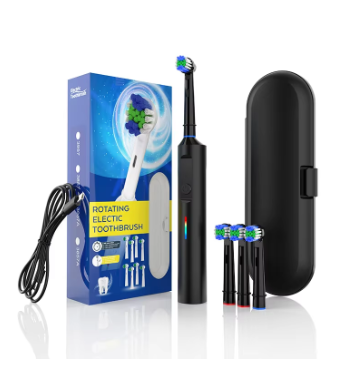How Electric Toothbrush Technology Works
Electric toothbrushes have revolutionized dental hygiene by enhancing how we clean our teeth. Let's explore the mechanisms that underpin their effectiveness and how they contribute to improved oral health.
Oscillating vs. Sonic Cleaning Mechanisms
Most electric toothbrushes work using either oscillating or sonic technology for cleaning teeth. The oscillating type moves its bristles back and forth like a spinning top, sweeping away plaque from all those hard to reach spots on our teeth. This motion actually covers more ground than regular brushing does. Sonic models take a different approach altogether though. They vibrate really fast, creating little waves in the mouth that clean not only the visible parts of teeth but also get into those tiny spaces between teeth and right along where gums meet teeth. These vibrations really boost plaque removal effectiveness according to research findings. A study in The Journal of Clinical Periodontology among others showed that people who switched to these electric options saw better results in keeping their mouths healthy. Over time this leads to fewer problems with gum inflammation too.
Advanced Bristle Movement Patterns
Electric toothbrush tech has come a long way, with new bristle designs and movement patterns making them much better at what they do. Many models now feature soft, tapered bristles that don't irritate sensitive gums yet still get rid of plaque effectively. Some brands have introduced something called 3D cleaning action where the bristles actually bend and move around to reach those tricky spots in back molars that regular brushes just can't access. Dental studies show people who switch to these newer electric brushes tend to have about 20% less plaque buildup compared to manual brushing. The industry keeps improving these gadgets too, so users benefit from better oral health results while enjoying a more comfortable brushing experience overall.
Automated Brushing Motion Advantages
Electric toothbrushes stand out for their automatic brushing action that helps people stick to proper brushing techniques without fail. The big plus here is better oral health results since there's less room for error compared to regular manual brushing where everyone does things differently. Most newer models come packed with clever tech too. Some count how long we brush each section of our mouth while others give gentle buzzes when we're spending too much time in one spot. Dentists often point to studies showing that folks who regularly use these brushes tend to get rid of plaque more effectively and generally have healthier mouths. What makes this automation so helpful isn't just making brushing easier, it actually teaches us how to brush properly over time, which means our teeth stay in good shape for years down the road.
Clinical Studies on Plaque Reduction
Clinical studies have shown time and again that electric toothbrushes beat out regular manual brushes when it comes to fighting plaque buildup. One key study in The Journal of Clinical Periodontology found people using electric brushes saw about 21% less plaque on their teeth after just three months of brushing, plus around 11% improvement in gum inflammation issues too. These results really highlight why so many folks are switching to electric models for better dental health overall. Dentists across the country, including those affiliated with groups like the American Dental Association, regularly recommend electric brushes to patients who want to maintain healthier mouths without all the guesswork involved in traditional brushing techniques.
Long-Term Gum Disease Prevention
Numerous studies point to one clear fact: people who stick with electric toothbrushes tend to get fewer cases of gum disease in the long run. Research spanning several years shows that those using these devices generally end up with healthier gums and less gingivitis compared to manual brushing alone. Dentists across the country keep emphasizing how this simple habit change can really cut down on problems later on. For most folks concerned about their smile staying healthy as they age, investing in an electric brush seems like common sense when looking at all the benefits it brings to daily oral care routines.
Impact on Cavity Formation Rates
Research shows there's a clear link between using electric toothbrushes and lower cavity rates, particularly for kids and teenagers. Long term tracking indicates people who brush with electric models tend to get fewer cavities overall, and this effect seems strongest in younger age groups. Dental professionals back these findings, pointing out that features like pressure sensors and rotating heads clean teeth more thoroughly than regular brushes ever could. The improved plaque removal makes a real difference in preventing those pesky cavities that so many struggle with. For parents looking to protect their children's dental health, switching to an electric toothbrush might just be one of the best investments they can make.

Essential Features for Optimal Dental Hygiene
Built-In Timers Ensuring Proper Duration
Electric toothbrushes with built in timers really matter when it comes to making sure people brush long enough, something basic but important for keeping teeth healthy. Most dentists say two full minutes is what folks need to get rid of plaque and leftover food stuck between teeth. The timer function helps everyone stick to this advice, which leads to healthier mouths overall. Research from the ADA backs this up showing folks who hit that two minute mark generally end up with much less plaque buildup than those who rush through or go overboard. And there's another handy feature worth mentioning too those little buzzes every 30 seconds remind us to switch sides and give all four sections of our mouth equal attention. This prevents bad habits where we might neglect certain areas, which can cause problems down the road if not addressed properly.
Pressure Sensors Protecting Gum Tissue
Electric toothbrushes often come equipped with pressure sensors that let people know when they're brushing too hard against their teeth. Brushing too forcefully can actually hurt gums over time, causing them to recede and expose sensitive root areas. Studies from places like the Journal of Clinical Periodontology show that gentle brushing makes all the difference for healthy gums. People who use these sensor-equipped brushes tend to notice improvements in their daily routine. They mention feeling more secure knowing they aren't damaging their gums accidentally. The real benefit here isn't just about avoiding problems down the road but also making brushing something people look forward to instead of dreading because they worry about hurting themselves.
Multiple Cleaning Modes for Specific Needs
Most electric toothbrushes come with several cleaning settings including sensitive, whitening, and deep clean options so people can pick what works best for them. These different modes really make a difference when dealing with particular mouth issues. The sensitive setting tends to be gentler on tender gums, whereas the whitening option helps take away those pesky surface stains that leave teeth looking dull. Dentists often recommend certain settings based on what someone's going through. Take coffee lovers or smokers for example they usually get told about the whitening mode specifically. With all these choices available, folks can actually tailor how they brush every day to suit exactly what their teeth need at any given time.
Comparison With Manual Brushing Effectiveness
Superior Plaque Removal Capabilities
Studies keep showing electric toothbrushes beat regular ones at removing plaque from teeth. Research actually points to better plaque removal with electric models compared to manual brushing. Take one recent trial published in The Journal of Clinical Periodontology for instance. After just three months of using an electric brush, participants saw about 21% less plaque buildup and around 11% improvement in gum inflammation issues. Most dentists will tell patients that those fancy moving heads or vibrating bristles on electric brushes explain why they work so much better. People who switch usually notice their mouths feel cleaner between checkups, which makes sense since good plaque control leads to healthier smiles overall.
Improved Access to Difficult Areas
Electric toothbrushes have a clear edge over regular brushes when it comes to reaching those tough spots in the mouth. Their special designs and moving heads can get into places that manual brushing just misses. People who switch usually find they clean better around molars and along the gum line where plaque builds up most. A lot of folks report seeing real differences after making the change from hand brushing to electric models. Dentists back this up too, pointing out that getting to those hard spots means fewer cavities down the road and healthier gums overall. The extra reach makes all the difference for maintaining good oral health long term.
Cost-Benefit Analysis Over Time
Looking at the numbers shows that getting an electric toothbrush actually pays off in the long run despite what many people think. Sure, these brushes cost more upfront than regular ones, but studies show they do a much better job at fighting plaque, which means saving money on dentist visits down the road. When someone maintains good oral hygiene with an electric brush, they typically end up with fewer cavities and problems with their gums. That translates into not needing expensive fillings or other treatments later on. Most dentists will tell patients that spending extra on an electric model makes sense for anyone serious about keeping teeth healthy without breaking the bank year after year.
FAQ
What are the main types of electric toothbrushes and how do they differ?
Electric toothbrushes mainly come in two types: oscillating toothbrushes and sonic toothbrushes. Oscillating toothbrushes rotate their heads back and forth to effectively remove plaque, while sonic toothbrushes use high-frequency vibrations for cleaning, including areas between teeth and along the gum line.
Are electric toothbrushes better than manual toothbrushes?
Yes, clinical studies show that electric toothbrushes can remove more plaque compared to manual toothbrushes, leading to better oral hygiene outcomes such as reduced gingivitis and cavity rates.
How do built-in timers and pressure sensors benefit dental health?
Built-in timers ensure that users brush for the recommended two minutes, promoting effective plaque removal. Pressure sensors alert users to apply the correct pressure, protecting gums and preventing damage to enamel.
Do electric toothbrushes prevent gum disease over the long term?
Research indicates that consistent use of electric toothbrushes significantly reduces the incidence of gum disease and maintains healthier gums over time.
What are the financial benefits of using an electric toothbrush?
Though initially more expensive, electric toothbrushes offer better plaque control, potentially saving costs on dental treatments for issues like cavities and gum disease in the long run.
Table of Contents
- How Electric Toothbrush Technology Works
- Clinical Studies on Plaque Reduction
- Long-Term Gum Disease Prevention
- Impact on Cavity Formation Rates
- Essential Features for Optimal Dental Hygiene
- Comparison With Manual Brushing Effectiveness
-
FAQ
- What are the main types of electric toothbrushes and how do they differ?
- Are electric toothbrushes better than manual toothbrushes?
- How do built-in timers and pressure sensors benefit dental health?
- Do electric toothbrushes prevent gum disease over the long term?
- What are the financial benefits of using an electric toothbrush?


